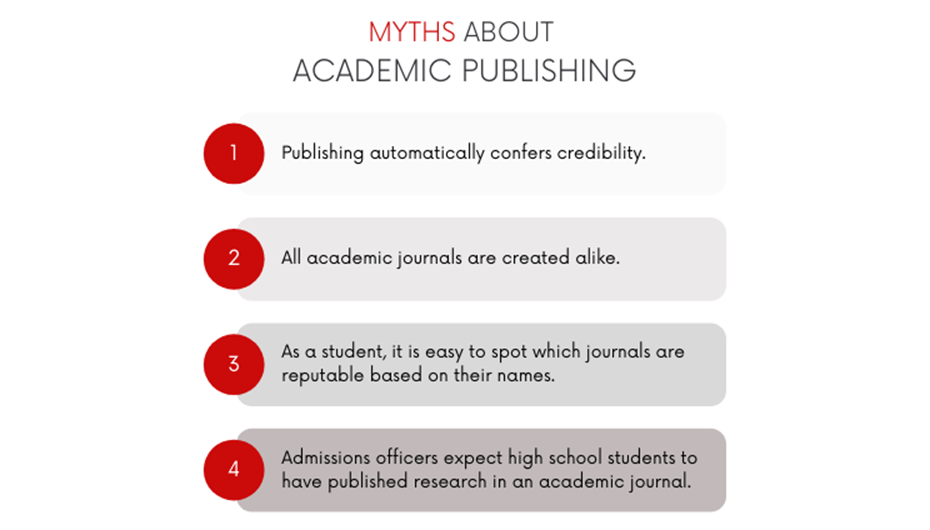Students and parents may feel like having an article published in an academic journal is the ultimate badge of accomplishment after conducting research. This isn’t surprising; who doesn’t like to see their work in print? However, the truth is more complicated. Publishing in reputable journals is very difficult and not accessible for most high school students. In order to meet the growing number of high school students who believe they must publish their research, a wide range of publishers have emerged, ranging from vanity press to outright predatory. We encourage students and parents to think carefully about publishing. Here, we address four myths about academic publishing as a high school student.
Myth #1: Publishing automatically confers credibility.
Research is credible when it is proven to follow rigorous academic standards and is certified by a reputable organization. Being published in a journal does not automatically make your research more credible. Research is made credible because of the academic system under which it was conducted and the process of inquiry that was undertaken. Just being in print does not make an article more reputable. Today, the ease of publication through a vanity press is such that anything can be published, so it is vitally important to dig into the specific journal.
Myth #2: All academic journals are created alike.
Not all academic journals are reputable. Credible academic journals have transparent editorial standards and a peer review system as well as rigorous selection processes. Journals that are not credible run the spectrum from vanity press models to predatory publishing. Predatory publishing is academic publishing that exploits authors by charging publication fees without vetting articles for quality or authenticity. Other journals, while not outright fraudulent, are essentially vanity presses and will publish anything for a fee. In 2005, scientists from MIT created SCIgen, a program that randomly generates nonsense computer science research papers.① Despite being randomly generated nonsense, several of these papers were accepted by predatory journals and conferences! This experiment highlighted the lack of scrutiny by some publishers.
Myth #3: As a student, it is easy to spot which journals are reputable based on their names.
While some predatory journals may be obviously suspicious, others are more insidious. It is important to do your research in order to determine the credibility of a given publisher. Reputable academic journals tend to have a transparent editorial board and membership in professional organizations or electronic databases. The Directory of Open Access Journals provides a list of reputable open-access journals. ②
Myth #4: Admissions officers expect high school students to have published research in an academic journal.
While being published in a reputable academic journal is a great accomplishment, it is not the norm for high school students. It is unusual even for undergraduates to have research published. College admissions officers know this, and being published is not a requirement or even the norm for admission into selective undergraduate institutions. Furthermore, reputable journals go through a long process of peer review which means that it may take 1.5 to 2 years for an article to be published. This means that by the time a student has been published in a journal, it will likely be after college admissions are already complete.
Despite what predatory publishers may try to convince high school students, it is better not to be published at all than to be published in a disreputable journal. At best, predatory publishing is the academic equivalent of a vanity press––just like anyone can self-publish a collection of stories on Amazon, anyone can pay to have articles published in a predatory journal. At worst, students may do damage to their reputation by associating with a fraudulent organization. It is important to approach publishing with caution and make an informed decision.
① https://pdos.csail.mit.edu/archive/scigen/
② https://doaj.org/
Register for FREE to comment or continue reading this article. Already registered? Login here.
0


